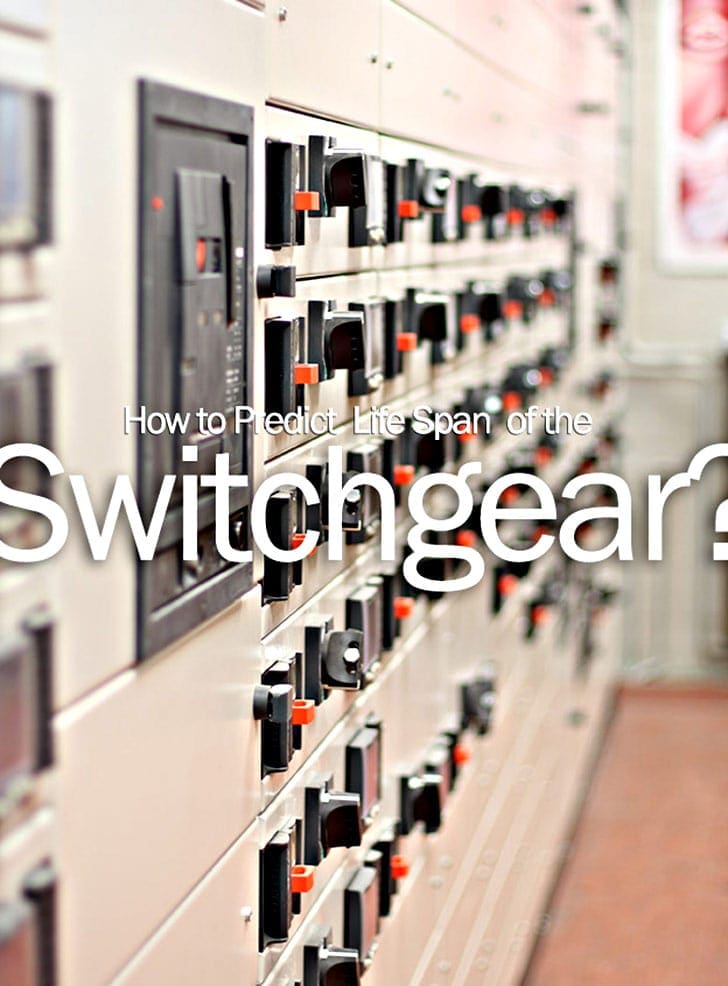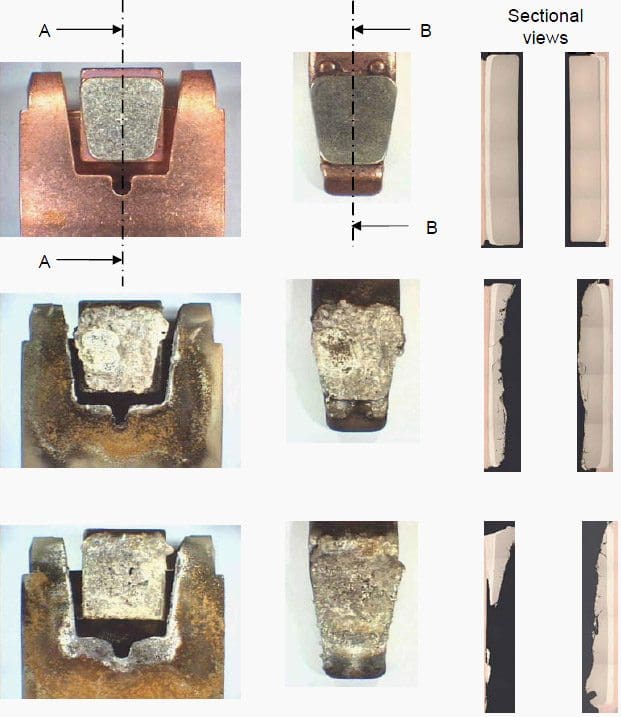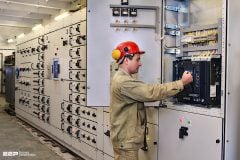Load and Number of Switching Cycles
The life span of switchgear basically depends on the size of the load and the number of switching cycles. Instead of a time span, with electromechanical switchgear reference is usually made to the number of operations, as the ageing mainly depends on the stress during switching and less on the on- and off-phases between.

The maximum number of operations is determined by the wear of heavily loaded components in:
- Contactors,
- Load switches and
- Circuit breakers especially of the contact system.
For switchgear, the mechanical and electrical life spans are separately defined. The mechanical life span states the number of possible operations without electrical loading, while the electrical life span states the number of operations for a certain size of electrical loading and a certain utilization category.
In electronic devices, the life span is usually less dependent on the number of operations but rather on the working temperature. Thus for example electrolytic capacitors (for example used in power adapters) age more quickly at higher temperatures.
This is why it is recommended to install electronic devices in the cooler parts of switch cabinets.
Full-range fuses (gL, gG) have a soldered joint for tripping in the overcurrent range that may age due for example to repeated short-term melting. When using them with motors with the latters’ high starting currents, it should therefore be ensured that the starting current does not raise the temperature of this solder joint beyond a certain limit.
Fuse manufacturers provide information on the smallest fuses that can be selected in relation to given motor currents and starting times.
Prospective Service Life
The prospective service life of switchgear is the number of years, months or weeks that it should complete under the foreseen service conditions in 1-, 2- or 3-shift operation without the replacement of spare parts. It depends on the frequency of operation and the total number of individual switching operations.
For the latter in addition to the mechanical also the electrical life span of the devices must be selected accordingly.
The required parameters can be determined by means of the below formulae:
ntot = fs x hD x dY x nY
nY = ntot / ( fs x hD x dY )
fs = ntot / ( nY x hD x dY )
ntot – Total number of operations (life span)
fs – Switching operations per hour
hD – Operating hours per day
dY – Operating days per year
nY – Number of years (life span)
Mechanical Life Span
The mechanical life span of switchgear is the total number of possible switch operations without electrical switch loading. It depends on the design, the masses moved, the forces and accelerations occurring.
On the other hand, contactors operate with relatively small contact forces and thus achieve longer mechanical life spans.
After the mechanical life span has expired, the devices must be replaced. This life span is only rarely achieved during the foreseen service life. In a few cases, where the complete mechanical life span has to be used, it should be ensured that it is not reduced by adverse ambient conditions, installation position and – in the case contactors – by an excessive control voltage.
Electrical Life Span
The electrical life span for switchgear is the number of possible switching operations under operational conditions. After this number has been reached, the parts subject to wear must be wherever possible replaced. With small devices, the entire device must be replaced.
Depending on the application, the loading and the resulting erosion of the contacts varies widely.
This is influenced by the following conditions, whereby the first mentioned play the dominant role:
- Breaking current
- Making current
- Voltage
- Power factor cos φ with alternating current
- Time constant τ with direct current
- Frequency of operation
- Malfunctions in the plant and on other devices (contact chatter)
- Ambient conditions (climate, temperature, vibrations)
Usually the electrical life span determined under test conditions is presented in diagrams as a function of the rated operational current. These values may generally be used without hesitation in contactor selection. In practical operation, the loads are usually lower, as the running motor usually carries a current that is below the rated operational current. In the case of longer inching operation, the starting current has already dropped somewhat by the time the motor is switched off.
This usually compensates for the effect of any disregarded adverse conditions.
For the most common applications of contactors the electrical life span is presented in the product documentation with various diagrams:
- AC-1 Non-inductive or slightly inductive loads, for example resistance furnaces
(small making current and cos φ higher than with AC-3, however full recurring voltage on switching off) - AC-3 Squirrel-cage induction motors: Starting, switching off motors during running
(high making current, breaking of the motor rated current) - AC-2 Slip-ring motors: Starting, switching off
- AC-4 Squirrel-cage motors: Starting, plugging, inching (high making and breaking current at full voltage)
- Mixed service of slip-ring motors, e.g.
– AC-3 90 %
– AC-4 10 %
With the curves Figure 1 for AC-3 and Figure 2 for AC-4 the expected electrical life span for specific applications can be determined.
These curves also can be used to determine the electrical life span for any application (for example jogging motors with very high or especially low starting current and any mixed service).

The diagram applies up to 460 V, 50/60 Hz.
Example 1
Background:
Squirrel-cage induction motor 7.5 kW, 400 V, 15.5 A, AC-3 (switching off only when running), operating cycle 2 minutes ON / 2 minutes OFF, 3-shift operation, expected service life 8 years.
Objective:
Selection of the contactor
Solution:
2 min ON + 2 min OFF = 15 switching operations/h. This results for 3-shift operation over 8 years in around 1 million switching operations.
From diagram Figure 1 yields for a rated operational current of 15.5 A and 1 million required switching operations the contactor C16 (electrical life span approx. 1.3 million switching operations).

The diagram applies up to Ue=690 V, 50/60 Hz.
Example 2
Background:
Squirrel-cage induction motor 15 kW, 400 V, 29 A, plugging, switching off rotor at standstill at IA = 6·Ie, expected life span = 0.2 million switching operations.
Objective:
Rating of starting and braking contactors.
Solution:
The starting contactor (circuit making only) is selected according to the maximum permitted rated power at AC-3 (see Figure 1): C30.
The brake contactor is selected according to the maximum permitted rated operational power at AC-4 and 0.2 million switching operations according to Diagram Figure 2 – C72.
For mixed service, i.e. service of the contactor with AC-3 and AC-4 switching operations, the life span results from the sum of the loadings. In the catalogs, diagrams for certain %-rates of AC-4 operations, for example 10 %, are provided. The RALVET electronic documentation is available for determining the life span for other percentage rates, or direct inquires must be made.
- More switching operations than expected, e.g. operated by extremely sensitive controller.
- More frequent inching than expected, e.g. unskilled operation.
- Permitted frequency of operation exceeded, e.g. chattering contacts
- Short-circuits, e.g. switching pause too short for reversing or star-delta starters.
- Synchronization with the supply voltage. Semiconductors as controllers could for example always switch off at the same phase angle and act in the same direction of current-flow
(results in one-sided material migration to the contacts like in direct current control).
Assessment of the Contacts
In conjunction with the electrical life span, the question often arises of assessment of contacts after a certain service period for continued serviceability. At least with large contactors, the contacts can be inspected.
Already after the first few switching operations, there are clear signs of burn-off on the contact surface. After a relatively small number of switching operations, the entire contact surface becomes roughened and blackened. Black deposits and traces of arc extinction can be seen on the surrounding components. Serrated edges and loss of contact material toward the arcing chamber are also normal.
The below figures are intended as an aid for an assessment of contacts.

Figure 3 left – Contacts in new state
Figure 3 center – Contacts after approx. 75 % of the electrical life span; Contact material partially eroded; contacts still operable
Figure 3 right – Contacts at the end of their life span; Substrate material visible, contact material eroded down to the substrate; further use would lead to contact welding and excessive temperature rise.
The pictures on the right show the contact state in long section. The images of the various life span phases originate from various contacts, as the contacts can no longer be used once the section has been cut.
Resource: Allen Bradley – Low Voltage Switchgear and Controlgear











I would like to find the source of the formulae for finding the number of years. I am doing a project on switchgear and would like to use the formulae.
Hi
Holec Switchgear installed Feb 2001 Manufacture Wilson Rating 300KVA
LV Switchgear Cat. 1. Manufacture Alstrom
Question: is there a policy or program which states must be overhauled every 10 years for the above mentioned switchgear.
Would appreciate advice. I am not in the industry and or any expert just work in a venue which is having massive issues with electricity and they are claiming every 10 years this must be overhauled . True or False?
thank you
We have an application where we give power supply to a 1.5HP single phase water pump for 12 hours; and for the rest 12 hours the pump is kept off. We give this power supply through timer switch and contactor circuit. The contactor is of 9amp capacity. How much life (in number of days) we should expect from contactor
I really appreciate all your posting on Electrical portal.
However, i Have a particular topic that i think can benefit many of us if you can help to address it. it is all about Electrical Load Flow calculation. if you can help us on it with a station one line diagram and step to be taking in solving such problem. such how to get the station requirement for upgrading.
i mean from S = P+jQ
Thanks